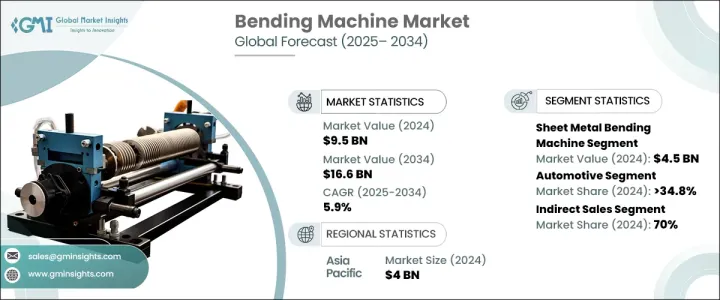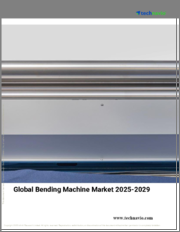
|
시장보고서
상품코드
1716452
벤딩머신 시장 기회, 성장 촉진 요인, 산업 동향 분석, 예측(2025-2034년)Bending Machine Market Opportunity, Growth Drivers, Industry Trend Analysis, and Forecast 2025 - 2034 |
||||||
세계 벤딩머신 시장은 2024년에 95억 달러로 평가되었으며, 2025년부터 2034년까지 연평균 복합 성장률(CAGR)은 5.9%를 나타낼 전망입니다.
벤딩 머신은 제조, 건설, 자동차, 항공우주 등 여러 산업에서 필수적인 역할을 하고 있습니다. 이에 따라 인프라와 건설 프로젝트가 급속히 확대되고 있는 신흥 경제국에서는 벤딩머신 수요가 증가하고 있습니다.

기술의 발전은 벤딩머신의 전망을 바꾸고 있으며, CNC와 로봇 모델은 뛰어난 효율성과 정밀도를 제공합니다. 프로그래밍과 관리에 익숙한 숙련된 오퍼레이터를 필요로 하기 때문에 기술적 전문지식이 부족한 기업에 있어서는 장벽이 됩니다.
| 시장 범위 | |
|---|---|
| 시작 연도 | 2024년 |
| 예측 연도 | 2025-2034년 |
| 시작 금액 | 95억 달러 |
| 예측 금액 | 166억 달러 |
| CAGR | 5.9% |
판금 벤딩 머신 부문은 2024년에 45억 달러로 평가되었고, 2034년까지 연평균 복합 성장률(CAGR)은 6.6%를 나타낼 전망입니다. 판금은 건설, 자동차, 항공우주, 전자, 제조 등의 산업에서 널리 사용되기 때문에 이러한 기계의 가치는 매우 높습니다. 복잡한 모양과 각도의 굽힘 가공이 우수하기 때문에 제조업체는 특정 설계 요구 사항을 높은 정확도로 충족시킬 수 있습니다. 파이프 벤딩 머신이나 튜브 벤딩 머신에 비해 판금 벤딩 머신은 대형 판을 가공할 때 비용면에서 유리하며 대규모 부품 생산에 경제적으로 적합합니다. 경량 소재의 채용과 커스터마이즈 부품의 요구 증가는 판금 벤딩머신 수요를 더욱 높여주고 있습니다.
시장은 최종 용도별로 항공우주 및 방위, 자동차, 일반기계 및 설비, 전기 및 전자, 헬스케어 및 해양용도를 포함한 기타로 구분됩니다. 자동차 분야는 2024년 시장 점유율의 34.8%를 차지했으며, 2034년까지 CAGR은 5.6%를 보일 것으로 예측됩니다. 벤딩 머신은 배기 시스템, 롤 케이지, 섀시 요소 등의 정밀하고 맞춤형 부품을 생산하는 자동차 제조에 필수적입니다. 자동차 제조업체가 연비와 성능 향상을 위해 알루미늄이나 고도 합금과 같은 경량 소재를 도입하는 것이 증가하고 있기 때문에 벤딩머신 수요는 계속 증가하고 있습니다.
아시아태평양은 2024년에 벤딩머신 시장에서 40억 달러의 수익을 올렸습니다. 자동차 부품, 구조요소, 가전제품을 포함한 폭넓은 부품을 생산하기 위한 벤딩머신 수요를 촉진하고 있습니다.
목차
제1장 조사 방법과 조사 범위
제2장 주요 요약
제3장 업계 인사이트
- 생태계 분석
- 공급자 상황
- 가격 분석
- 기술과 혁신의 전망
- 주요 뉴스 및 이니셔티브
- 규제 상황
- 제조업체
- 판매자
- 세력에 대한 영향
- 성장 촉진요인
- 산업화의 진전과 인프라 개발
- 제조업의 급성장
- 제조 기술의 진보
- 업계의 잠재적 위험 및 과제
- 고액의 초기 투자
- 숙련 노동자의 부족
- 성장 촉진요인
- 성장 가능성 분석
- Porter's Five Forces 분석
- PESTEL 분석
제4장 경쟁 구도
- 소개
- 기업 점유율 분석
- 경쟁 포지셔닝 매트릭스
- 전략 전망 매트릭스
제5장 시장 추정 및 예측 : 유형별, 2021년-2034년
- 주요 동향
- 판금 벤딩머신
- 파이프/튜브 벤딩 머신
- 기타(프레스 브레이크, 롤 포밍, 바 벤딩)
제6장 시장 추정 및 예측 : 구동 기구별, 2021년-2034년
- 주요 동향
- 전동
- 유압
- 공압
- 기계
제7장 시장 추정 및 예측 : 운전 기술별, 2021년-2034년
- 주요 동향
- 기존
- 컴퓨터 수치 제어(CNC)
제8장 시장 추정 및 예측 : 최종 용도별, 2021년-2034년
- 주요 동향
- 항공우주 및 방위
- 자동차
- 일반기계 및 설비
- 건축 및 건설
- 기타(광업, 해양 등)
제9장 시장 추정 및 예측 : 유통 채널별, 2021년-2034년
- 주요 동향
- 직접 판매
- 간접판매
제10장 시장 추정 및 예측 : 지역별, 2021년-2034년
- 주요 동향
- 북미
- 미국
- 캐나다
- 유럽
- 영국
- 독일
- 프랑스
- 이탈리아
- 스페인
- 러시아
- 아시아태평양
- 중국
- 인도
- 일본
- 호주
- 한국
- 라틴아메리카
- 브라질
- 멕시코
- 아르헨티나
- 중동 및 아프리카
- UAE
- 남아프리카
- 사우디아라비아
제11장 기업 프로파일
- Amada
- Amob
- Baileigh Industrial
- BLM Group
- Bystronic Group
- Euromac
- Horn Machine Tools
- Murata Machinery
- Pedax
- Prima Industrie
- Sahinler Metal Makina Industry
- Shuz Tung Machinery Industrial
- Transfluid
- Trumpf
- Wafios
The Global Bending Machine Market was valued at USD 9.5 billion in 2024 and is expected to grow at a CAGR of 5.9% from 2025 to 2034. Bending machines play an integral role across multiple industries, including manufacturing, construction, automotive, and aerospace. These machines are used to shape sheet metal, pipes, tubes, and profiles, making them indispensable in producing complex components and structures. As global industrialization accelerates, the demand for bending machines is increasing, especially in emerging economies where infrastructure and construction projects are expanding rapidly. The rising adoption of automation and precision engineering in various sectors further boosts market growth, driving demand for advanced bending machines that can handle intricate designs with high accuracy.

Technological advancements are transforming the bending machine landscape, with CNC and robotic models offering superior efficiency and precision. However, the high acquisition and maintenance costs of these advanced machines can be a significant challenge, particularly for smaller manufacturers in emerging economies. Additionally, these machines require skilled operators proficient in programming and managing complex systems, posing a barrier for companies with limited technical expertise. Despite these challenges, the growing emphasis on automated processes and customized component production is fueling the adoption of advanced bending machines across industries.
| Market Scope | |
|---|---|
| Start Year | 2024 |
| Forecast Year | 2025-2034 |
| Start Value | $9.5 Billion |
| Forecast Value | $16.6 Billion |
| CAGR | 5.9% |
The sheet metal bending machine segment generated USD 4.5 billion in 2024 and is projected to grow at a CAGR of 6.6% through 2034. Sheet metal is extensively used across industries such as construction, automotive, aerospace, electronics, and manufacturing, making these machines highly valuable. They excel in bending intricate shapes and angles, enabling manufacturers to meet specific design requirements with high precision. Compared to pipe or tube bending machines, sheet metal bending machines offer cost advantages when processing larger sheets, making them economically viable for large-scale component production. The growing adoption of lightweight materials and the need for customized parts further enhance the demand for sheet metal bending machines.
The market is segmented by end-use into aerospace & defense, automotive, general machinery & equipment, electrical & electronics, and others, including healthcare and marine applications. The automotive segment accounted for 34.8% of the market share in 2024 and is expected to grow at a CAGR of 5.6% through 2034. Bending machines are essential in automotive manufacturing, where they create precise and customized components such as exhaust systems, roll cages, and chassis elements. As automakers increasingly incorporate lightweight materials like aluminum and advanced alloys to improve fuel efficiency and performance, the demand for bending machines continues to rise.
Asia Pacific generated USD 4 billion in revenue from the bending machine market in 2024. The region hosts major manufacturing hubs, particularly in the automotive, aerospace, construction, and electronics sectors. Rapid industrial expansion and infrastructure development in countries like China, India, and South Korea are driving the demand for bending machines to produce a wide range of components, including automotive parts, structural elements, and consumer electronics. The region's emphasis on technological innovation and precision manufacturing is expected to propel market growth, making the Asia Pacific a dominant player in the global bending machine industry.
Table of Contents
Chapter 1 Methodology & Scope
- 1.1 Research design
- 1.1.1 Research approach
- 1.1.2 Data collection methods
- 1.2 Base estimates and calculations
- 1.2.1 Base year calculation
- 1.2.2 Key trends for market estimates
- 1.3 Forecast model
- 1.4 Primary research & validation
- 1.4.1 Primary sources
- 1.4.2 Data mining sources
- 1.5 Market definitions
Chapter 2 Executive Summary
- 2.1 Industry synopsis, 2021 - 2034
Chapter 3 Industry Insights
- 3.1 Industry ecosystem analysis
- 3.2 Supplier Landscape
- 3.3 Pricing analysis
- 3.4 Technology & innovation landscape
- 3.5 Key news & initiatives
- 3.6 Regulatory landscape
- 3.7 Manufacturers
- 3.8 Distributors
- 3.9 Impact on forces
- 3.9.1 Growth drivers
- 3.9.1.1 Increasing industrialization and infrastructure development
- 3.9.1.2 Rapid growth in the manufacturing sector
- 3.9.1.3 Advancements in manufacturing technologies
- 3.9.2 Industry pitfalls & challenges
- 3.9.2.1 High initial investment
- 3.9.2.2 Shortage of skilled labor
- 3.9.1 Growth drivers
- 3.10 Growth potential analysis
- 3.11 Porter's analysis
- 3.12 PESTEL analysis
Chapter 4 Competitive Landscape, 2024
- 4.1 Introduction
- 4.2 Company market share analysis
- 4.3 Competitive positioning matrix
- 4.4 Strategic outlook matrix
Chapter 5 Market Estimates & Forecast, By Type, 2021 - 2034 ($Bn) (Thousand Units)
- 5.1 Key trends
- 5.2 Sheet metal bending machine
- 5.3 Pipe/tube bending machine
- 5.4 Others (press brake, roll forming, bar bending)
Chapter 6 Market Estimates & Forecast, By Driving Mechanism, 2021 - 2034 ($Bn) (Thousand Units)
- 6.1 Key trends
- 6.2 Electric
- 6.3 Hydraulic
- 6.4 Pneumatic
- 6.5 Mechanical
Chapter 7 Market Estimates & Forecast, By Operating Technology, 2021 - 2034 ($Bn) (Thousand Units)
- 7.1 Key trends
- 7.2 Conventional
- 7.3 Computer numerically controlled (CNC)
Chapter 8 Market Estimates & Forecast, By End Use, 2021 - 2034 ($Bn) (Thousand Units)
- 8.1 Key trends
- 8.2 Aerospace & defense
- 8.3 Automotive
- 8.4 General machinery & equipment
- 8.5 Building & construction
- 8.6 Others (mining, marine, etc.)
Chapter 9 Market Estimates & Forecast, By Distribution Channel, 2021 - 2034 ($Bn) (Thousand Units)
- 9.1 Key trends
- 9.2 Direct sales
- 9.3 Indirect sales
Chapter 10 Market Estimates & Forecast, By Region, 2021 - 2034 ($Bn) (Thousand Units)
- 10.1 Key trends
- 10.2 North America
- 10.2.1 U.S.
- 10.2.2 Canada
- 10.3 Europe
- 10.3.1 UK
- 10.3.2 Germany
- 10.3.3 France
- 10.3.4 Italy
- 10.3.5 Spain
- 10.3.6 Russia
- 10.4 Asia Pacific
- 10.4.1 China
- 10.4.2 India
- 10.4.3 Japan
- 10.4.4 Australia
- 10.4.5 South Korea
- 10.5 Latin America
- 10.5.1 Brazil
- 10.5.2 Mexico
- 10.5.3 Argentina
- 10.6 MEA
- 10.6.1 UAE
- 10.6.2 South Africa
- 10.6.3 Saudi Arabia
Chapter 11 Company Profiles
- 11.1 Amada
- 11.2 Amob
- 11.3 Baileigh Industrial
- 11.4 BLM Group
- 11.5 Bystronic Group
- 11.6 Euromac
- 11.7 Horn Machine Tools
- 11.8 Murata Machinery
- 11.9 Pedax
- 11.10 Prima Industrie
- 11.11 Sahinler Metal Makina Industry
- 11.12 Shuz Tung Machinery Industrial
- 11.13 Transfluid
- 11.14 Trumpf
- 11.15 Wafios



















